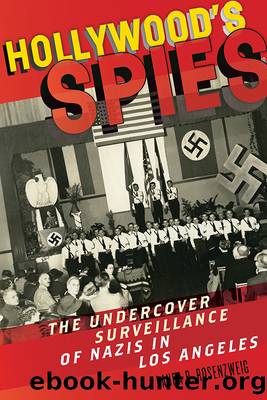Hollywood's Spies by Laura B. Rosenzweig

Author:Laura B. Rosenzweig [Rosenzweig, Laura B.]
Language: eng
Format: epub
Tags: HIS000000 History / General
Publisher: NYU Press
8
The Dies Committee
âFederal Agents Smash Spy Ring.â âArmy Secrets Sold: Girl Held in Conspiracy.â âLeader Confesses, More Arrests Expected.â1 On February 27, 1938, headlines across the country announced that the FBI had broken up a Nazi spy ring in New York City. For the next ten months, newspapers around the country reported on the sensational Rumrich espionage trial.2 Sensational revelations of Nazi spy activity in the United States from the trial heightened fears of a Nazi fifth column at home and renewed public pressure on Congress to again investigate Nazi activity in the United States. In May 1938, Congress responded by passing Texas congressman Martin Diesâs resolution to âinvestigate (1) the extent, character, and objects of un-American propaganda activities in the United States; (2) the diffusion within the United States of subversive and un-American propaganda that is instigated from foreign countries or of a domestic origin and attacks the principle of the form of government as guaranteed by our Constitution; and (3) all other questions in relation thereto that would aid Congress in any necessary remedial legislation.â3
Dies was named chairman of the new committee charged to investigate âun-American activitiesâ in the United States. Dies, a conservative southern Democrat who had a well-deserved reputation as a red-baiter, promised an evenhanded investigation of âall organizations or groups existing in the United States which are directed, controlled or subsidized by foreign governments or agencies and which seek to change the policies and form of government of the United States in accordance with the wishes of such foreign governments.â The objective of the committee, Dies said, was to shine âthe critical light of dayâ on these groups, regardless of their political ideology, âand trust public sentiment to do the rest.â4
The Dies Committee posed a serious political dilemma to anti-Nazi Jewish resistance groups. On the one hand, the new congressional investigation was the first significant opportunity they had had in four years to leverage the power of the federal government to expose Berlinâs intrusion into American political culture. On the other hand, Leon Lewis and his colleagues in New York and Chicago understood that the political winds that had swept the new committee into power had blown in from the right. Martin Dies was a âtypi[cal] old southern style confederateâ who wore his nativism on his sleeve.5 Just three years earlier, Dies had opposed emergency immigration legislation that would have allowed thousands of European Jewish refugees into the country, claiming that âthe Eastern European alienâ posed a significant threat to â[our] great, white, homogenousâ civilization.6 For Dies, communism posed the greatest threat to America, and Jews for Dies were synonymous with communists. Jewish leaders at the ADL and AJC, along with Lewis in Los Angeles, feared that Dies would turn the new committee into an accomplice for the very far-right-wing groups they hoped to defeat.7 American Jewish defense groups concluded that they could not allow a congressional investigation of the âredâ Trojan horse in America without providing evidence of the âbrownâ one.8
Frosty relations between Leon Lewis and Richard Gutstadt thawed temporarily with the creation of the Dies Committee.
Download
This site does not store any files on its server. We only index and link to content provided by other sites. Please contact the content providers to delete copyright contents if any and email us, we'll remove relevant links or contents immediately.
| Espionage | Hoaxes & Deceptions |
| Murder & Mayhem | Organized Crime |
| Serial Killers | White Collar Crime |
Mindhunter: Inside the FBI's Elite Serial Crime Unit by John E. Douglas & Mark Olshaker(9206)
Wiseguy by Nicholas Pileggi(5674)
Room 212 by Kate Stewart(5040)
Hitman by Howie Carr(5022)
Secrecy World by Jake Bernstein(4651)
Killers of the Flower Moon: The Osage Murders and the Birth of the FBI by David Grann(4387)
Papillon (English) by Henri Charrière(4199)
Breaking Free by Rachel Jeffs(4175)
Killers of the Flower Moon by David Grann(3971)
Say Nothing by Patrick Radden Keefe(3903)
American Kingpin by Nick Bilton(3759)
The Secret Barrister by The Secret Barrister(3615)
Molly's Game: From Hollywood's Elite to Wall Street's Billionaire Boys Club, My High-Stakes Adventure in the World of Underground Poker by Molly Bloom(3486)
Mysteries by Colin Wilson(3397)
In Cold Blood by Truman Capote(3311)
Signature in the Cell: DNA and the Evidence for Intelligent Design by Stephen C. Meyer(3075)
I'll Be Gone in the Dark by Michelle McNamara(3024)
Rogue Trader by Leeson Nick(2977)
Bunk by Kevin Young(2950)
